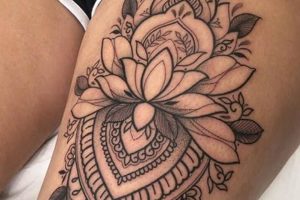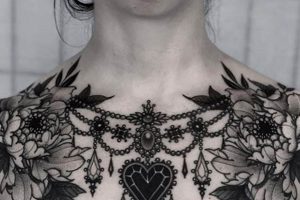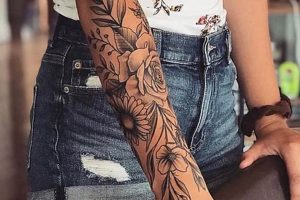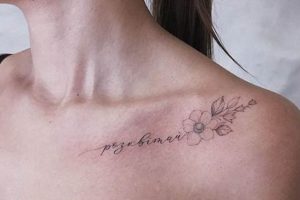Concealing unwanted ink is a common practice, and finding suitable designs specifically for women involves considering factors such as existing tattoo size, location, color saturation, and personal style preferences. Examples include transforming a tribal armband into a floral piece or covering a small, faded name with a delicate butterfly.
Updating or completely concealing a tattoo empowers women to reclaim their bodies and express their current identities. This can be particularly significant for tattoos representing past relationships, outdated aesthetics, or simply poorly executed artwork. Historically, tattooing practices have varied widely across cultures and genders, with contemporary methods offering greater flexibility in modification and removal. The increasing prevalence of cover-ups reflects evolving personal narratives and improved tattooing techniques.
This article will explore various design concepts tailored to women seeking cover-up solutions, including stylistic considerations, the consultation process, and factors influencing successful concealment. Specific examples and practical advice will be offered for navigating this transformative process.
Tips for Tattoo Cover-Ups for Women
Several factors contribute to a successful cover-up. Careful planning and consideration of these elements are essential for achieving desired results.
Tip 1: Consult with Experienced Artists: Expertise in cover-up techniques is crucial. Seek artists specializing in this area and review their portfolios for relevant examples.
Tip 2: Consider Tattoo Size and Location: Larger, darker tattoos require more intricate designs. Body placement also influences potential cover-up options.
Tip 3: Explore Color Theory: Darker inks are more effectively covered by darker colors. Understanding color theory is vital for seamless blending and concealment.
Tip 4: Embrace Larger Designs: Cover-ups often necessitate larger designs than the original tattoo. Be prepared for increased size and potential cost implications.
Tip 5: Evaluate Existing Tattoo Design: The original tattoo’s style, lines, and colors will influence the feasibility and effectiveness of various cover-up options.
Tip 6: Manage Expectations: Perfect concealment may not always be achievable. Realistic expectations regarding the final result are important.
Tip 7: Prioritize Aftercare: Proper aftercare is essential for both the cover-up and the underlying original tattoo. Follow artist instructions diligently for optimal healing.
Careful selection of a skilled artist and realistic design expectations significantly increase the likelihood of a successful and aesthetically pleasing outcome.
These tips provide a starting point for exploring cover-up options. The following sections will delve deeper into specific design considerations and the practical aspects of the cover-up process.
1. Size and Placement
The size and placement of the existing tattoo significantly influence cover-up options for women. These factors determine design complexity, feasibility, and ultimately, the success of the concealment process. Understanding this relationship is crucial for informed decision-making.
- Existing Tattoo Size
Larger tattoos present a greater challenge, often requiring proportionally larger cover-up designs. Smaller tattoos offer more flexibility, allowing for a wider range of design choices, including complete concealment or incorporation into a new, larger piece. A small, faded name on the wrist might be easily covered with a floral design, while a large tribal piece on the back would require a more substantial and intricate approach.
- Body Placement
The location of the original tattoo impacts design choices and artist accessibility. Tattoos in areas with more complex contours, such as the ribs or ankle, may limit design options. A cover-up on the inner forearm might require a design that flows with the natural curves of the arm, while a cover-up on a flatter area like the back offers more design freedom. Placement also influences visibility and personal preference for concealment.
- Cover-up Design Size
Cover-ups typically require designs larger than the original tattoo to effectively conceal the unwanted ink. This necessitates careful consideration of the desired final size and its aesthetic impact. A small, simple tattoo might be covered by a design two or three times its size, while a larger piece might require a significantly larger cover-up, potentially impacting cost and healing time.
- Relationship Between Existing and New Design
The size and placement of the existing tattoo dictate the relationship with the new design. The cover-up may completely obscure the original or incorporate elements of the existing design into the new artwork. A faded portrait might be incorporated into a larger, more elaborate floral design, while a solid black band might be transformed into the base of a geometric pattern.
Careful evaluation of size and placement empowers informed decisions regarding design choices, artist selection, and overall expectations for the cover-up process. These factors are fundamental to achieving a successful and aesthetically pleasing outcome tailored to individual needs and preferences.
2. Color and Style
Color and style play crucial roles in successful tattoo cover-ups for women, impacting both the effectiveness of the concealment and the aesthetic appeal of the new design. Careful consideration of color theory and stylistic choices ensures a harmonious blend between the existing tattoo and the cover-up, minimizing visibility and maximizing artistic expression.
Darker inks are more challenging to conceal, often requiring darker pigments in the cover-up design. Understanding color theory enables artists to select appropriate shades that effectively neutralize or incorporate the existing ink. For example, a dark blue tattoo might be covered with a deep purple or black design, while lighter colors can be layered over faded or less saturated tattoos. Stylistic choices should complement the desired aesthetic, whether it’s realistic, abstract, or a specific cultural motif. A watercolor-style cover-up might be suitable for concealing a faded, pastel-colored tattoo, while a bold, geometric design might be more effective for covering a tribal tattoo. The interplay between color and style allows for creative solutions, transforming unwanted ink into personalized works of art.
Effective color and style choices enhance the overall aesthetic of the cover-up, ensuring a cohesive and visually appealing result. The cover-up should not only conceal the unwanted tattoo but also stand alone as a beautiful piece of art. Consideration of individual skin tone, personal style preferences, and the expertise of the tattoo artist contributes to informed decision-making and successful outcomes. Challenges may arise when attempting to cover very dark or large tattoos, requiring strategic color choices, intricate designs, and potentially multiple sessions. Ultimately, a harmonious blend of color and style is essential for achieving a successful and aesthetically pleasing tattoo cover-up.
3. Artist Expertise
Artist expertise is paramount in the realm of tattoo cover-ups for women. A skilled artist possesses a deep understanding of color theory, design principles, and skin interaction with ink, enabling effective concealment and aesthetically pleasing transformations. This expertise influences every stage of the process, from initial consultation and design conceptualization to the technical execution of the cover-up. An experienced artist can assess the existing tattoo’s characteristicssize, color saturation, location, and skin typeto determine the most suitable cover-up approach. For instance, an artist specializing in realism might employ intricate layering and shading techniques to seamlessly blend the new design with the existing ink, while an artist proficient in geometric styles might create bold patterns to effectively obscure unwanted elements. The ability to visualize the final outcome and anticipate potential challenges distinguishes a skilled cover-up artist.
Practical examples illustrate the significance of artist expertise. A faded, amateur tattoo might be successfully transformed into a vibrant, professional piece by an artist skilled in color correction and blending. Conversely, an inexperienced artist might exacerbate the issue, resulting in a muddy or uneven cover-up. Furthermore, a skilled artist understands the limitations of cover-up techniques. Certain tattoos, due to their size, color density, or location, may not be entirely concealable. An ethical artist will honestly assess the situation and manage client expectations, offering alternative solutions or modifications to achieve the best possible outcome. This transparency and professionalism are hallmarks of true expertise.
Successful tattoo cover-ups depend heavily on artist expertise. Choosing a skilled artist with a strong portfolio of cover-up work is a crucial step in this transformative process. Thorough consultation, realistic expectations, and an understanding of the technical complexities involved contribute to achieving satisfying and aesthetically pleasing results. The investment in experienced artistry ensures not only effective concealment but also the creation of a new piece of body art that empowers and reflects individual style.
4. Design Inspiration
Design inspiration forms the foundation for successful tattoo cover-ups, particularly for women seeking aesthetically pleasing and meaningful transformations. The inspiration behind a cover-up design significantly influences its effectiveness in concealing unwanted ink and its ability to empower the individual with a new, expressive piece of body art. Exploring various sources of inspiration allows for personalized designs that resonate with personal style, experiences, and aspirations.
- Nature-Inspired Designs
Floral motifs, botanical elements, and animal imagery offer versatile options for cover-ups. These designs can be adapted to various sizes and styles, effectively concealing existing tattoos while adding a touch of natural beauty. A faded tribal armband, for example, could be transformed into a flowing vine with delicate blossoms, or a small, unwanted name could be covered with a vibrant butterfly or hummingbird. The organic shapes and vibrant colors of nature-inspired designs provide ample opportunity for creative concealment.
- Geometric and Abstract Patterns
Geometric patterns and abstract designs provide strong visual elements that can effectively obscure unwanted ink. Mandala patterns, intricate linework, and abstract shapes offer versatility in size and placement, adapting well to various body contours. A dark, solid tattoo can be concealed with a layered geometric design, while a faded or less saturated tattoo might be incorporated into a flowing abstract piece. These styles offer a modern and visually striking approach to cover-ups.
- Symbolic and Meaningful Imagery
Cover-ups can be imbued with personal meaning, transforming a negative experience into a positive expression of self. Symbolic imagery, such as meaningful quotes, spiritual symbols, or representations of personal growth, empowers individuals to reclaim their bodies and tell their stories. A tattoo representing a past relationship might be covered with a phoenix, symbolizing rebirth and renewal, or a meaningful quote might be incorporated into a design that reflects personal values and aspirations.
- Cultural and Traditional Motifs
Drawing inspiration from cultural or traditional art forms offers a rich source of cover-up ideas. Elements from specific cultures, such as Japanese Irezumi, Polynesian tribal designs, or Celtic knotwork, can be adapted and incorporated into cover-up designs, adding depth and personal significance. These designs often feature bold lines and intricate details, making them effective for concealing existing tattoos while celebrating cultural heritage.
By exploring these diverse sources of design inspiration, women can create personalized cover-ups that not only conceal unwanted ink but also serve as powerful expressions of individuality and personal growth. Collaborating with a skilled artist to translate these inspirations into a cohesive and aesthetically pleasing design is crucial for achieving a successful and empowering transformation.
5. Skin Tone
Skin tone plays a critical role in determining the effectiveness and aesthetics of tattoo cover-ups for women. Ink interacts differently with varying skin tones, influencing color vibrancy, longevity, and the overall success of the concealment process. Understanding the interplay between skin tone and ink is crucial for selecting appropriate cover-up designs and achieving desired results. Melanin content, the primary determinant of skin tone, affects how ink pigments appear on the skin. Darker skin tones with higher melanin concentrations absorb and disperse light differently, potentially muting the vibrancy of certain ink colors. Lighter skin tones, with lower melanin content, allow for greater color vibrancy and clarity. Consequently, cover-up designs must be tailored to individual skin tones to ensure effective concealment and optimal aesthetic outcomes. For example, covering a dark tattoo on darker skin might require darker pigments layered strategically, while a similar cover-up on lighter skin might allow for a wider range of color choices.
Practical considerations regarding skin tone extend beyond color selection. Healing processes can also vary depending on melanin content. Individuals with darker skin tones are more prone to keloid scarring and hyperpigmentation, which can impact the final appearance of the cover-up. A skilled artist will consider these factors, adjusting techniques and aftercare recommendations to minimize potential complications and optimize healing. Furthermore, certain ink colors are more susceptible to fading on specific skin tones. Lighter colors, such as pastels, may fade more quickly on darker skin, while darker colors may appear more prominent. These factors influence long-term cover-up effectiveness and necessitate careful consideration during the design process. Consulting with an experienced artist specializing in diverse skin tones is essential for navigating these complexities and achieving successful, long-lasting results.
Skin tone is an integral factor in successful tattoo cover-ups for women. Understanding its impact on ink visibility, healing, and long-term color retention empowers informed decisions regarding design choices and artist selection. Careful consideration of individual skin tone ensures that the cover-up effectively conceals unwanted ink while enhancing personal aesthetics. Ignoring this crucial element can compromise the effectiveness and longevity of the cover-up, potentially necessitating further corrections or revisions. Prioritizing skin tone considerations during the consultation and design process leads to more satisfying and aesthetically pleasing outcomes.
6. Pain Tolerance
Pain tolerance is a significant individual factor influencing tattoo cover-up decisions for women. Cover-ups often require more extensive work than original tattoos due to the need to neutralize existing ink and create a new design. This can translate to longer sessions and potentially increased discomfort. A woman’s individual pain tolerance directly impacts design choices, session length, and the overall cover-up experience. For example, someone with a lower pain tolerance might opt for a less intricate design or consider multiple shorter sessions to manage discomfort. Conversely, someone with a higher pain tolerance might be more open to larger, more complex designs requiring longer single sessions. Understanding and acknowledging individual pain thresholds are crucial for both the client and the artist to develop a realistic and manageable approach.
Practical applications of this understanding involve open communication between the client and the artist during the consultation process. Discussing pain management strategies, such as topical anesthetics or breaks during the session, can significantly improve the overall experience. The artist can also adjust techniques, such as needle depth and speed, to minimize discomfort within the client’s tolerance level. Furthermore, choosing a design that aligns with pain tolerance can contribute to a more positive and successful outcome. Opting for designs with less dense shading or fewer intricate details can reduce overall session time and discomfort, particularly for individuals with lower pain thresholds. Ignoring pain tolerance can lead to premature termination of sessions, compromising the cover-up’s quality and potentially necessitating further corrective work.
Pain tolerance is an essential factor to consider when planning a tattoo cover-up. Open communication, realistic expectations, and appropriate pain management strategies are crucial for a positive experience and a successful outcome. Acknowledging and accommodating individual pain thresholds contribute to informed decision-making and ensure that the cover-up process is both manageable and ultimately empowering.
7. Budget Considerations
Budget considerations are integral to planning a tattoo cover-up, significantly influencing design choices and artist selection. Cover-ups often require more intricate work and longer sessions than original tattoos, impacting overall cost. Understanding the financial implications empowers informed decisions and ensures alignment between desired outcomes and budgetary constraints. Failing to address budget considerations upfront can lead to compromises in design, artist selection, or session frequency, potentially affecting the final result.
- Artist Rates and Experience
Experienced artists specializing in cover-ups often command higher hourly rates, reflecting their expertise and demand. Researching and comparing artist rates within a specific region or specialization helps establish realistic budget expectations. Opting for a less experienced artist solely based on lower rates might compromise the cover-up’s quality, potentially necessitating further corrective work and ultimately increasing overall costs.
- Design Complexity and Size
Intricate designs, larger cover-ups, and those requiring multiple sessions contribute to increased costs. The size and complexity of the existing tattoo also influence the cover-up’s design requirements and subsequent cost. A small, faded tattoo might require a less complex and less expensive cover-up compared to a large, darkly saturated tattoo requiring multiple sessions and more intricate artwork. Balancing design aspirations with budgetary constraints is essential for a successful outcome.
- Color Usage and Materials
Certain pigments, particularly specialized or high-quality inks, can influence the overall cost. Cover-ups requiring extensive color correction or the use of specific ink types might incur additional expenses. Discussing color choices and material preferences with the artist during the consultation phase helps clarify cost implications and facilitates informed decision-making. Transparency regarding material costs ensures alignment between artistic vision and budgetary limitations.
- Additional Sessions and Revisions
Cover-ups occasionally require multiple sessions, especially for larger or more complex designs, increasing overall costs. Unforeseen complications or the need for revisions can also contribute to additional expenses. Factoring potential additional sessions into the initial budget planning helps mitigate financial surprises and ensures adequate resources for achieving the desired outcome. Open communication with the artist regarding session frequency and potential revisions promotes financial transparency and informed decision-making.
Addressing budget considerations proactively is crucial for women seeking tattoo cover-ups. A clear understanding of cost drivers empowers informed decisions regarding design choices, artist selection, and session planning. Aligning budgetary limitations with realistic expectations ensures a positive experience and a successful transformation of unwanted ink into a cherished piece of body art. Ignoring budget considerations can compromise the quality and longevity of the cover-up, potentially leading to further expenses and dissatisfaction.
Frequently Asked Questions
Addressing common inquiries regarding tattoo cover-ups provides clarity and facilitates informed decision-making. This section aims to dispel misconceptions and offer practical guidance for individuals considering this transformative process.
Question 1: Can any tattoo be covered up?
While many tattoos can be effectively concealed, complete coverage depends on factors such as size, color saturation, location, and skin tone. Darker, larger tattoos present greater challenges. Consulting an experienced artist is essential for assessing feasibility.
Question 2: How long does a cover-up take?
Cover-up procedures often require more time than initial tattoo application due to the complexities of concealing existing ink. Session length varies based on design intricacy, size, and individual factors. Multiple sessions might be necessary.
Question 3: Is a cover-up more painful than a new tattoo?
Pain perception varies among individuals. Cover-ups might involve working over existing scarred tissue, potentially influencing sensitivity. Open communication with the artist regarding pain management strategies is recommended.
Question 4: How much does a cover-up cost?
Cost depends on several factors, including artist experience, design complexity, size, and number of sessions required. Cover-ups often incur higher costs than original tattoos due to the technical challenges involved. Obtaining quotes from multiple artists is advisable.
Question 5: How long after a tattoo can it be covered up?
Complete healing of the original tattoo is crucial before initiating a cover-up, typically requiring several months. Premature cover-ups can impede proper healing and compromise the final result. Consulting an artist for assessment is essential.
Question 6: What are the most effective cover-up designs?
Effective cover-up designs often incorporate darker colors, bold lines, and strategic layering to conceal existing ink. Geometric patterns, floral motifs, and organic shapes are frequently employed. Artist expertise guides design selection based on individual circumstances.
Careful consideration of these frequently asked questions equips individuals with the knowledge necessary to navigate the cover-up process effectively. Consulting with experienced artists and establishing realistic expectations are crucial for achieving desired results.
The following section will delve into specific design considerations and examples tailored to women seeking transformative cover-up solutions.
Conclusion
Exploring options for concealing unwanted ink involves careful consideration of various factors. Design elements, artist expertise, individual skin tone, pain tolerance, and budget constraints all play significant roles in successful transformations. Effective concealment requires strategic planning, open communication with experienced artists, and realistic expectations regarding achievable outcomes. From size and placement considerations to color theory and stylistic choices, informed decision-making empowers individuals to reclaim their bodies and express their evolving identities through thoughtfully chosen cover-up designs.
Transforming unwanted tattoos into empowering expressions of personal style requires a thoughtful and informed approach. Embracing the transformative potential of cover-up artistry allows individuals to rewrite their narratives, reclaiming their bodies and expressing their authentic selves. The journey towards successful concealment necessitates careful consideration of individual factors and a collaborative approach with skilled artists. Ultimately, the fusion of artistic expertise and personal expression empowers individuals to embark on a transformative path toward self-discovery and renewed confidence.







